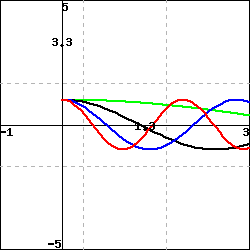In this problem we find the eigenfunctions and eigenvalues of the differential equation
on the interval with boundary values
For the general solution of the differential equation in the following cases use A and B for your constants, for example . For the variable type the word lambda, otherwise treat it as you would any other variable.
Case 1:
(1a.) Ignoring the boundary conditions for a moment, the general solution for the differential equation is
.
Apply the boundary conditions to the general solution to obtain two equations relating to :
=
=
(1b.) Solving this system for A and B we get
A =
B =
Case 2:
(2a.) Ignoring the boundary conditions for a moment, the general solution is
.
Apply the boundary conditions to obtain two equations relating to :
=
=
(2b.) If and are not both zero then, solving these two equations, one can eliminate both and and derive the following formula for in terms of hyperbolic functions (, etc.).
(2c.) Choose the graph of and
From the graph there are
nonzero eigenvalues for ,
Sturm-Loiuville guarantees infinitely many eigenvalues, so we go on.
Case 3:
(3a.) Ignoring the boundary conditions, the general solution is
.
Apply the boundary conditions to obtain two equations relating to :
=
=
(3b.) Assuming and are not both zero then, solving these two equations, one can eliminate both and and derive the following formula for in terms of trigonometric functions.
(3c.) In increasing order, the first four eigenvalues from this equation are:
(Your answers should be accurate to at least 7 decimal places.)
List the first three eigenfunctions in order of increasing eigenvalues.
,
,
Here are graphs of the first four eigenfunctions on .

List the functions, ordered by their eigenvalues in increasing order, by their color - green, red, blue, black:
You can earn partial credit on this problem.